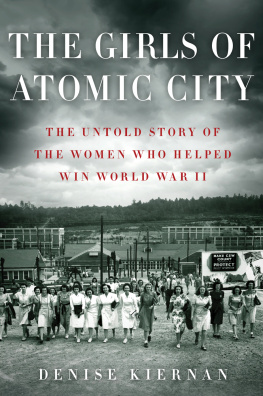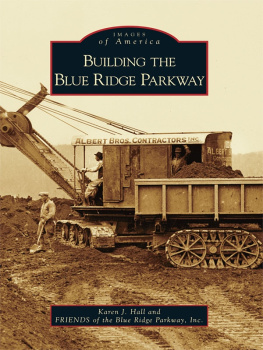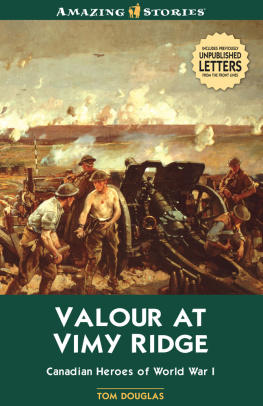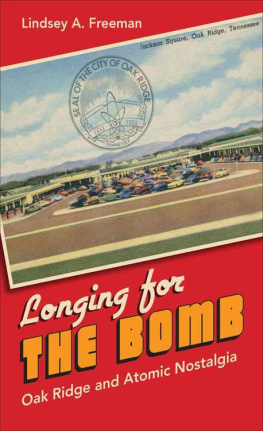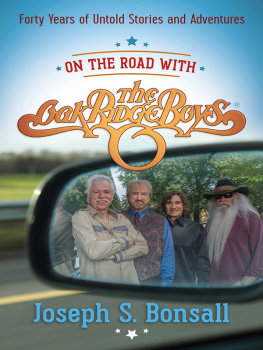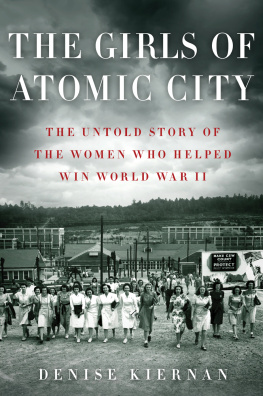Thank you for purchasing this Touchstone eBook.
Join our mailing list and get updates on new releases, deals, bonus content and other great books from Touchstone and Simon & Schuster.
C LICK H ERE T O S IGN U P
or visit us online to sign up at
eBookNews.SimonandSchuster.com
For Joe
Contents
Introduction
There have long been secrets buried deep in the southern Appalachians, covered in layers of shale and coal, lying beneath the ancient hills of the Cumberlands, and lurking in the shadow of the Smokies at the tail end of the mountainous spine that ripples down the East Coast. This land of the Cherokee gave way to treaties and settlers and land grants. Newcomers traversed the Cumberland Gap to establish small farms and big lives in a region where alternating ridges and valleys cradle newborn communities in the nooks and crannies of the earth. Isolated. Independent. Hidden.
In 1942, a new secret came to this part of the world. The earth trembled and shook and made way for an unprecedented alliance of military, industrial, and scientific forces, forces that combined to create the most powerful and controversial weapon known to mankind. This weapon released the power present in the great unseen of the time, unleashing the energy of the basic unit of matter known as the atom.
Author H. G. Wells might have called them Sun Snarers, the people who descended upon the valleys and ridges.
And we know now that the atom, that once we thought hard and impenetrable, and indivisible and final andlifelesslifeless, is really a reservoir of immense energy... , Wells wrote in his 1914 book, The World Set Free . This lesser-known title by the War of the Worlds author describes the harnessing of the power of the nucleus: And these atomic bombs which science burst upon the world that night were strange even to the men who used them.
Wells wrote this long before the neutron was discovered, let alone fission, and his work began to popularize the phrase atomic bombs before those devices ever took form beyond the authors pages. But years earlier, people in the mountains claim another prophet lay on the ground, overcome with visions of a project that would bring the snaring of the sun to the hills of Tennessee.
They say a prophet foretold it.
A general oversaw it.
And a team of the worlds greatest scientific minds was tasked with making it all come together.
But it was the others, the great and often unseen, who made the visions of the Prophet and the plans of the General and the theories of the scientists a reality. Tens of thousands of individualssome still reeling from the Depression, others gripped by anxiety and fear as loved ones fought overseas in the most devastating war any of them had knownworked around the clock on this project, the details of which were not explained. For the young adventurers, male and female, who traveled to Oak Ridge, Tennessee, during World War II, doing their part meant living and working in a secret city, a place created from the ground up for one reason and one reason onlyto enrich uranium for the worlds first atomic bomb used in combat.
Roots have always run deep here. They were dug up and scattered when the strangers with the project came to the foothills of the Cumberlands, but the newcomers, too, could not resist the pull of the earth and dug their own roots down deep into the Tennessee clay, soaked by mountain rain and baked by a thousand suns. Permanent. Enduring.
Many of these workers on this secret project hidden in the hills were young women who had left home to fight the war in their own way. They left farms for factories willingly, wrote letters hopefully, waited patiently and worked tirelessly.
A number of these womenand menstill live in Oak Ridge, Tennessee, today. I have had the fascinating and humbling privilege of meeting them, interviewing them, laughing and crying with them and hearing firsthand their tales of life in a secret city while working on a project whose objective was largely kept from them. Over the years they have graciously given me their time and suffered through repeated questions and what must have seemed like insane requests to recall moments from their day-to-day activities roughly 70 years ago. They did so happily and enthusiastically and never, ever with even the slightest bit of bravado. That is not their style. I did not only learn about life on the Manhattan Project. I also found myself taken aback by their sense of adventure and independence, their humility, and their dedication to the preservation of history. I wish I could include each and every one of them in these pages, but I cannot. I hope those who find themselves only in the acknowledgments will accept my thanks in place of my prose. I feel exceptionally lucky to know those who continue to live on, and miss those who have passed since I began working on this book.
Without them, this sun-snaringthis Manhattan Projectwould not have achieved its objectives, and because of them a new age was born that would change the world forever.
These are some of their stories.
Denise Kiernan,
summer 2012
Principal Cast of Characters
PEOPLE
(THE WOMEN, IN ORDER OF APPEARANCE)
Celia Szapka
A secretary transferred from the Manhattan Projects original offices in New York City, Celia grew up in the coal-mining town of Shenandoah, Pennsylvania.
Toni Peters
A secretary from neighboring Clinton, Tennessee, Toni heard about the Project from its beginnings, when the government seized her aunt and uncles farm to make way for the secretive town.
Jane Greer
A statistician-mathematician from Paris, Tennessee, Jane oversaw a team of young women who crunched numbers around the clock to track the production rates of the Y-12 plant.
Kattie Strickland
A janitorial services worker from Auburn, Alabama, Kattie came to Oak Ridge with her husband to work at K-25.
Virginia Spivey
A chemist from Louisburg, North Carolina, Virginia came to Oak Ridge after graduating from the University of North Carolina. She worked in the chemical department of Y-12 analyzing product.
Colleen Rowan
A leak pipe inspector at the K-25 plant, Colleen left Nashville, Tennessee, for Oak Ridge, along with more than 10 members of her extended family.
Dorothy Jones
A calutron cubicle operator from Hornbeak, Tennessee, Dot was recruited right out of high school.
Helen Hall
A calutron cubicle operator and sports fanatic from Eagleville, Tennessee, Helen was recruited from the small coffee shop and pharmacy where she worked.
Rosemary Maiers
A nurse from Holy Cross, Iowa, Rosemary came to Oak Ridge to help open the very first clinic.
OTHER WOMEN OF NOTE
Vi Warren
A columnist for the Oak Ridge Journal and wife of the Project medical chief, Stafford Warren.
Ida Noddack
German geochemist who suggested the possibility of fission years before its discovery.
Lise Meitner
Austrian physicist who escaped Nazi Germany and was part of the team that discovered fission.
Leona Woods
American physicist who worked on the first-ever sustained nuclear reaction.
Mrs. H. K. Ferguson
Representing the H. K. Ferguson Company, principal contractor for the S-50 plant. Her real name shall be revealed....
Joan Hinton
American physicist who worked with Enrico Fermis team at Los Alamos, New Mexico.
Elizabeth Graves
American physicist who worked on the neutron reflector that surrounded the core of the Gadget.
PEOPLE (THE OTHERS)
The General
General Leslie Groves, head of the Manhattan Project.
Next page
